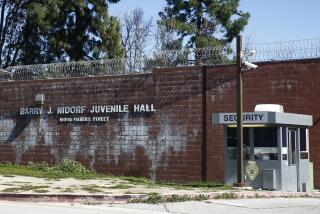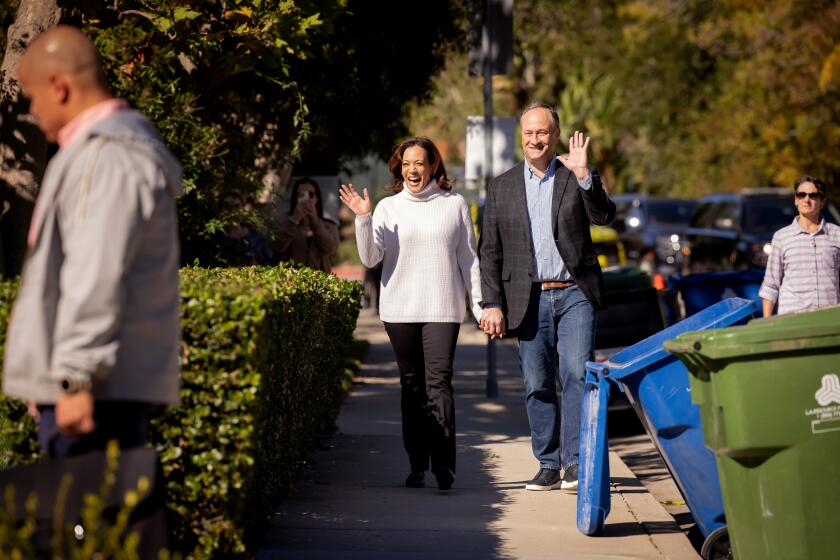Poor Areas Pin Hopes on Facility for Sex Offenders
In much of California, economic development means luring the latest Internet start-up or building a pedestrian mall. But such paths to prosperity have largely evaded two rural communities that are poised to stake their economic futures on a less obvious growth opportunity: housing the state’s sexually violent predators.
Civic leaders in the San Joaquin Valley town of Coalinga and in the Imperial Valley east of San Diego are competing to house a locked hospital that will one day hold 1,500 of California’s most dangerous serial rapists and child molesters.
In campaigning for the first-of-its-kind state hospital, political leaders in both communities are venturing where few others dare tread. Their decision has caused some backlash, particularly in Imperial Valley, where opponents say they are sick of being the dumping ground for the state’s wealthy and crowded cities.
But proponents remain unbowed. They talk about the hospital’s potential for bolstering the local tax base and the spending power that 2,500 doctors, nurses and other hospital employees could bring to their tired burgs.
‘A Lot of Economic Sense’
“We are a town that is battling for its survival economically,” said Coalinga City Councilman Larry McVicar, an associate warden at a nearby prison. “I think a lot of people say ‘Why not Coalinga?’ It could have been General Motors or it could have been anything. The hospital just makes a lot of economic sense.”
The need for such a facility arose four years ago when California lawmakers approved a law allowing the state to keep violent repeat sexual offenders in a locked hospital beyond the ends of their prison sentences.
Psychiatrists must first determine that an offender is likely to commit new crimes. Then a judge or jury must commit the inmate for treatment--a process that must be repeated every two years.
There are 314 such violent sexual predators at Atascadero State Hospital, one of several lockups for the criminally insane. But the facility doesn’t have enough room for the 800 sexual predators expected to be in custody by 2004.
In the search for a hospital site strictly for sexual predators, the state Department of Mental Health has had a few basic criteria. The community must welcome the hospital and it must also be home to a state prison, because guards from the prison will provide perimeter security around the hospital.
But many of California’s prison towns quickly rejected the hospital. The Tehachapi City Council voted down the facility last year, when more than 300 residents packed council chambers in opposition. Next, Soledad opted out. Then, late in 1999, the Atascadero City Council unanimously voted down the hospital. Many residents protested that the new facility would spoil the Central Coast town’s reputation. Others said they worried about escapes.
John Rodriguez, head of the site search for the mental health agency, said he believes that only one person in the state has a harder job than his: the man who tries to sell reclaimed waste as drinking water.
“The term ‘sexually violent predator’ is a killer for us,” said Rodriguez, director of long-term care for the Department of Mental Health. “But you can’t hide from it. That is who these guys are.”
Perhaps it should be no surprise that one of the two remaining contenders is in the heart of the poorest county in the state, a tract west of El Centro and adjacent to Centinela State Prison in Imperial County.
More than 22% of the county’s adults are unemployed. About 31% of its residents live in poverty. Its broad, flat fields are among the state’s most productive agricultural lands. But most of the jobs are seasonal and low-paying. The county seat of El Centro, population 37,000, has a core of spacious and well-tended homes, but it is girdled by neighborhoods of dusty apartments and crumbling shacks.
“Jobs are real, real hard to find down here,” said Larry Ram, 38, a clerk at El Centro Book and Video in the city’s old-fashioned downtown. “Those guys are going to be in lockup, you know, not running around in the streets, and we’ve already got two prisons in the area. What’s the big deal?”
That sentiment is common in the business community and elsewhere in town. But others question how much the community would really gain from the new hospital.
Critics Skeptical About Benefits
“Most people here are thinking, ‘If everyone else in the state has rejected this, why are we so lucky to still want it?’ ” said Tom Gargiulo, a 68-year-old rancher. “Many people feel like we are being taken advantage of down here, like we just don’t have any clout and we are a dumping ground.”
Gargiulo and other opponents question whether many of the hospital’s doctors and nurses will live locally, or simply commute from San Diego. They are skeptical of the state’s promises that it will help pay the costs for schools and other facilities.
As a June 15 deadline for submitting formal bids to the state looms, the hospital is favored by a 3-2 majority on the county Board of Supervisors. But opponents contend that they have gathered as many as 15,000 signatures against the hospital (a figure proponents call inflated). Some even threaten to force a recall election against county Supervisor Wally Leimgruber, who has been the most outspoken proponent of the hospital.
Emotions have been more muted in Coalinga, the west Fresno County foothill town that boomed at the turn of the century with the discovery of oil.
As the oil has dried up and jobs have disappeared, the community has been scrambling for jobs beyond the Kmart and a few shops and restaurants.
Coalinga’s biggest boon in recent years has been the opening of Pleasant Valley State Prison, a gray series of blockhouses four miles outside of town, beside cotton fields and rows of pistachio saplings. When the town annexed the prison last year, the 4,800 new “citizens” made Coalinga the fastest growing community in the state. The added residents injected an extra $200,000 in state revenues that are apportioned on the basis of population.
The prison has become a substantial presence in Coalinga in other ways. On a recent day, inmates helped clean up and plant flowers downtown in preparation for the annual Horned Toad Festival. And three of five City Council members, including associate warden McVicar, are employed by the prison.
The council has unanimously supported the hospital, reflecting the view of many residents and, particularly, the Chamber of Commerce.
“We want this thing so bad,” said Gary LaHue, owner of LaHue’s Jumping Java Joint, a coffeehouse. “There are going to be lots of doctors and nurses and there are lots of businesses here that could use the business. We haven’t had the population to support us before.”
But other locals are skeptical that highly paid doctors will flock to a small town (pop. 15,200) with a sleepy main street, only a few restaurants and no department stores. They worry about how their town is perceived.
“If you were Frito-Lay or Pepsi Cola and you wanted to relocate to the I-5 corridor, would you move to the sexual predator capital of California?” asked Barbara Lucas, a teacher who led a petition drive against the hospital. “I see us as taking one bite of the economic apple now and losing out on five bites later.”
But most locals, if they object, have been much more resigned.
Helen Cowan, curator of a local historical museum full of oil drilling gear and pictures of the gushing wells of yesteryear, said: “I don’t want to be known as the prison town. I grew up here. But the city people are just going to do what they want.”
Said Jeffrey Vaughn, a humanities instructor at West Valley Community College: “This town is not easily roused to action.”
Indeed, in both Coalinga and the Imperial Valley, opponents have demanded that voters get a chance to say how they feel about the hospital. Elected officials have denied them. The consensus has been that it would take too long or cost too much to force a ballot measure via a petition drive.
So civic leaders are pressing ahead with their applications to the state Department of Mental Health. Coalinga’s leaders suggest their town is more centrally located and a more desirable place to live. In the Imperial Valley, leaders say they have more potential employees living near the hospital site.
But the leadership in both areas has mostly been preoccupied with what the state can do for them. They desperately hope for the kind of financial support that other towns have received when prisons opened--as much as $6 million in subsidies for schools and other government services.
The question at Coalinga City Hall and the Imperial County administrative offices is: Does a request for too much compensation weaken a bid for the hospital?
“I would hate to think our state agencies are pitting cities and counties against each other for projects,” said Robertta Burns, county administrative officer in Imperial County. “If the state needs to build a facility, they ought to do what the private sector does: Pick the best location and then pay for the cost of the impact on the community.”
But Burns concedes that Imperial’s fragile economic state has left it with less leverage than many other areas.
“It’s a tough situation when the rest of the state is growing,” she said, “and you are still struggling along.”
(BEGIN TEXT OF INFOBOX / INFOGRAPHIC)
A Home for Sex Offenders
The towns of Coalinga and El Centro are competing to become home to the lockup for California’s sexually violent predators.
*
Rainey reported from Coalinga and De Turenne from El Centro.
More to Read
Get the L.A. Times Politics newsletter
Deeply reported insights into legislation, politics and policy from Sacramento, Washington and beyond. In your inbox three times per week.
You may occasionally receive promotional content from the Los Angeles Times.











